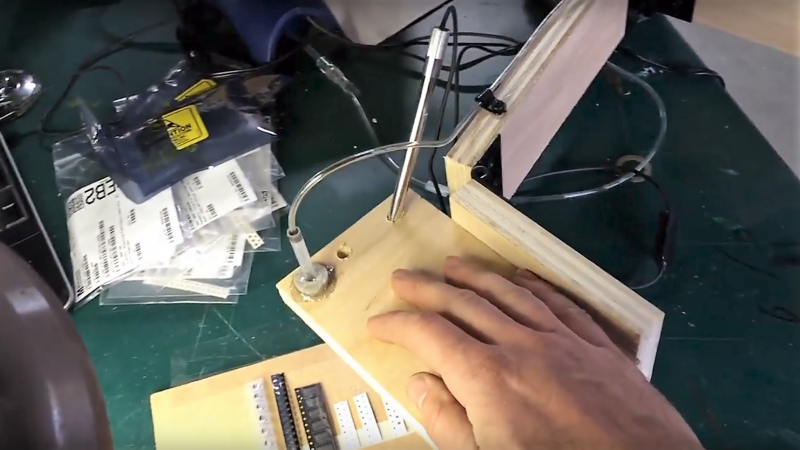With the fine work needed for surface-mount technology, most of the job entails overcoming the limits of the human body. Eyes more than a couple of decades old need help to see what’s going on, and fingers that are fine for manipulating relatively large objects need mechanical assistance to grasp tiny SMT components. But where it can really fall apart is when you get the shakes, those involuntary tiny muscle movements that we rarely notice in the real world, but wreak havoc as we try to place components on a PCB.
To fight the shakes, you can do one of two things: remove the human, or improve the human. Unable to justify a pick and place robot for the former, [Tom] opted to build a quick hand support for surface-mount work, and the results are impressive considering it’s built entirely of scrap. It’s just a three-piece arm with standard butt hinges for joints; mounted so the hinge pins are perpendicular to the work surface and fitted with a horizontal hand rest, it constrains movement to a plane above the PCB. A hole in the hand rest for a small vacuum tip allows [Tom] to pick up a part and place it on the board — he reports that the tackiness of the solder paste is enough to remove the SMD from the tip. The video below shows it in action with decent results, but we wonder if an acrylic hand rest might provide better visibility.
Not ready for your own pick and place? That’s understandable; not every shop needs that scale of production. But we think this is a great idea for making SMT approachable to a wider audience.
















This is a neat idea. I guess the next step would be some kind of pantograph linkage that could improve placement accuracy.
Exactly what I was thinking!
next level for diy
https://www.youtube.com/watch?v=BQKZtIUcPfA
or strap arduino to this one
http://www.ebay.com/itm/173219842411
Simple but effective! I love it, thanks for sharing.
Or 3D print one..
https://hackaday.io/project/45404-arcus-3d-p1-pnp-for-3d-printers
Nice hack. Seems like the solder paste works OK for pulling the parts off the vacuum tip, but if you need a way to release the parts, drill a hole in the side of the syringe and use your finger to plug or open the hole. I’ve used vacuum wands with holes and they work very well.
Thanks! I was planning on doing originally this but decided to try and just control the suction via a tee and a valve to see if it would work and it did. I have a hand held one that has a hole to release the vac
I find placing ICs TQFPs etc, easiest with a light source directly below the part. (Assuming your board does not have power planes)
If this is all you can contribute, please go away.
I’ve never seen this before, think it’s a great idea, and will probably try something similar.
I agree, this is simple but effective. Not every project needs to have an arduino or has to be 3d printed. Some things are just little practical devices from what you think of “why haven’t I thought if that yet”. So I guess in the near future I I will be making this, partially just for fun but with the knowledge I could certainly use it someday.
The claim “everyone does this” does not apply to my surroundings and I must say that I’m surrounded by some very practical and technically talented people.
This is, by far, (the best), my favorite hack EVAR!
Doing this tomorrow.
I learned one thing from old westerns where a washed up veterinarian has to remove a bullet from someone. The cure (and cause) for the shakes is whiskey. You’re welcome.
Cool idea! If one didn’t have the hinges on hand, I bet an articulating TV or monitor wall mount could make a good boom.
The SMT assembly method for printed circuit boards is very important for compact circuit design used in technologically advanced electronic devices. Surface mount technology has the following advantages when used in PCB assembly:
This technology saves a lot of space and is therefore ideal for compact PCBs
The installation process produces less noise than traditional processes
Using this technology, electronic components can be placed on both sides of a printed circuit board
Using the SMT method can greatly increase component density and the number of interconnections between components
SMT assembly method is very suitable for custom PCB
This technique is useful when assembling under shaky and vibratory conditions
This technology is very cost effective
For high-end and sophisticated boards, SMT PCB assembly technology is perfect. It saves time , costs and delivers outstanding results.